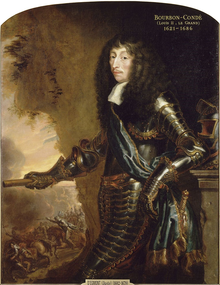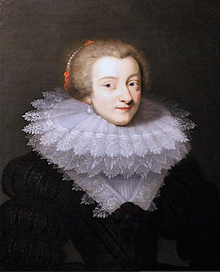The earliest years of Louis XIV were marked by the tumultuous period known as the Fronde. During this time, several aristocrats and parliamentarians rose up against the king, Louis XIII, after the king had issued seven edicts - including ones to raise taxes to fund the war against Spain. While the background is further complicated than this (as is usually the case with a civil war) the main question was the king's power - especially when contrasted with those of the Parlements and his nobility. The Fronde was technically two separate rebellions that occurred immediately following each other. The latter was known as La Fronde des Nobles - or the Nobility's Fronde - as it was led by the Prince de Condé.
In the end, Louis XIV's mother, Anne of Austria, and Cardinal Mazarin won the day - if they had not, the absolute monarchy of the Sun King would likely never have happened. The aftermath posed several vital questions. The French aristocracy had been split between those loyal to the crown and the so-called Frondeurs. With the king (or rather Queen Regent and Cardinal, given that the king was five years old) emerging victorious the question remained - what of those who stood against them?
While the Frondeurs counted many more aristocrats than listed here, this post focusing on the more prominent members of the French nobility who found themselves on the losing side - and the price they paid for it.
Gaston de Bourbon, Duc d'Orléans
The brother of Louis XIII, Gaston appeared to never fully have taken the leading position that his high birth would otherwise suggest. Initially, he had supported Cardinal Mazarin but appears to have changed his mind; in 1651 he joined the coalition of nobles who ousted Cardinal Mazarin. It is likely this choice of action that saved him from further retribution - had he been an open opponent to the king from the beginning, he might have been punished more severely.
Consequence of rebellion: Gaston was exiled to the Château de Blois - he would never return to court as he died there in 1660. His dukedom of Orléans was given to Louis XIV's brother, Philippe, rather than Gaston's surviving daughter Anne Marie Louise.
Louis de Bourbon, Prince de Condé
Louis de Bourbon - better known as the Grand Condé - was the driving force behind the aristocratic Fronde. Ironically, he had initially been summoned by Anne of Austria to quash the opposition from the Parlement (the previous Fronde) and certain other aristocrats. This he did quite successfully. However, much to the shock of Anne of Austria, he then turned and become the focal point of the Fronde des Nobles. He was arrested in 1650 and imprisoned at Vincennes.
The Grand Condé was released following demands from his brother, the Duc de Bouillon, and the Marèchal de Turenne. Tensions were at an all-time high when the aristocratic Fronde found itself alone; the Parliamentarian had made common cause with the royal family. The Marèchal de Turenne was amongst those who had joined the royal side; he and Condé came head-to-head at the decisive Battle of Faubourg St. Antoine in July 1652. Unluckily for the Grand Condé, he suffered a final defeat.
He was not done yet, though, although the chance for him to overthrow the royal party by military force was over. La Grande Mademoiselle ordered her soldiers to open fire on the king's soldiers before the Bastille and convinced the Parisians to open the gates to the capital. Thus, Louis de Bourbon-Condé managed to escape to Spain with his closest allies.
Consequence of rebellion: by 1659, the Franco-Spanish War came to an end with the Treaty of the Pyrenees. This meant that Louis de Bourbon-Condé found himself in the unpleasant situation of having to choose between going into exile somewhere else - or bending the knee to the Sun King. He chose the latter and was officially welcomed back to court with his official titles restored; nevertheless, he was never again given the opportunity for having decisive power. Understandably, Louis XIV kept a close eye on his relative.
 |
| Le Grand Condé |
Henri de La Tour d'Auvergne, Marèchal de Turenne
 |
| Turenne |
Armand de Bourbon, Prince de Conti
Armand's role in the Fronde was largely decided by his siblings (the Prince de Condé and the Duchesse de Longueville) since Armand's mental health was declining. Still, he was named generalissimo of the Frondeurs and as such held considerable sway in the movement. He was arrested with La Grande Condé in 1650 and taken to Vincennes. Sometime during his imprisonment he sustained a wound to the head which enabled him to smuggle messages out when he was visited by his doctors. He was released with his brother in 1651 only to face an uphill battle. Armand retreated to Bordeaux where he eventually surrendered to the royal forces in 1653.
François de Bourbon-Vendôme, Duc de Beaufort
The Duc de Beaufort was already in prison when the Fronde broke out; he found himself there after his part in a plot to assassinate Cardinal Mazarin. He managed to escape, though, and joined forces with the Frondeurs. In Paris, he was a general favourite with the public due to his looks and the fact that he was a legitimised son of the immensely popular Henri IV.He acted as one of the leading generals of the rebellion and personally led the patrols circling Anne of Austria to prevent her from escaping with the young Louis XIV.
Consequence of rebellion: he was exiled and not recalled until 1658. Wisely, he chose to focus on his post as admiral rather than make himself too noticed at court
 |
| Duc de Beaufort |
Anne-Geneviève de Bourbon-Condé, Duchesse de Longueville
If the Fronde had a First Lady, it would have been the Duchesse de Longueville. The first Fronde was largely centered around her - and she brought both her husband and brother (Prince de Conti) into it. Her failure was in attempting to convince her other brother, the Prince de Condé.However, once the latter had joined the Frondeurs, she acted as a focal point for the rebellion and used her talent for persuasion and many connections to further their cause. When the war was coming to an end she went into the region of Aquitaine
Consequence of rebellion: following her two unsuccessful attempts at thwarting the crown, she was persona non grata at court. Having been abandoned by her lover, the Duc de La Rochefoucauld, she rejoined her husband and dedicated herself to Jansenism and charity for the remainder of her life
 |
| The Duchesse de Longueville - ironically, she is depicted as peace and concord |
Jacques Henri de Durfort, Duc de Duras
Jacques Henri had initially supported the Prince de Condé but decided to abandon the rebellious cause for the royal one. It is likely that he was lured by the promise of several prestigious titles; shortly after his return to court, he was name lieutenant-general.
His quick return to royal grace meant that there were no consequences for his initial disloyalty - rather, the Duc de Saint-Simon mentions that he was able to say whatever he pleased in front of Louis XIV
 |
| Duc de Duras |
Henri II de La Trémoille, Duc de Thouars
Henri lend his services as a soldier to the Prince de Condé - and quite openly supported him in public. Apparently, he had long been at odds with Cardinal Mazarin.
Consequence of rebellion: imprisonment until 1658 in Amiens. He was only released after several months of petitioning by his mother and promptly shipped to Poitou and further to the Netherlands to serve in the military. He kept a very low profile after the Fronde and focused on maintaining his father's estates

Charles-Amédée de Savoie-Nemours, Duc de Nemours
The Frondeurs might have appreciated the support of another duke in their cause but they soon came to regret the inclusion of Charles Amédée. Rather than being an asset, he caused considerable chaos in his own camp by ill-timed flirtation with his comrades' wives and constant bickering with his brother-in-law.
The Duc de Nemours would eventually participate in the final salute of the Fronde, the Battle of the Faubourg St. Antoine where he was wounded. He would not live to see the end of the rebellion, though, as he was killed in a duel by his brother-in-law, the Duc de Beaufort.
François de La Rochefoucauld, Duc de La Rochefoucauld
Originally, François had been a friend of Anne of Austria but the increasing power of Cardinal Mazarin set the two on collision course - and it certainly did not help that the Duc's mistress was the Duchesse de Longueville. Soon, therefore, he found himself on the side of the Frondeurs.
He partook in the defence of Paris from the royal forces and would later fight in the Battle of the Faubourg St. Antoine where he was shot in the head. Miraculously, he survived that and spent the next year recovering. Once he returned to health, his circumstances had drastically changed. His fortune was diminished and he was not particularly welcome at court.
Consequence of rebellion: he slowly reclaimed some of his fortune through his friends and finally returned to court when Mazarin died. He appears to have turned his focus from sieges to salons and wrote his memoirs in the following period
 |
| Duc de La Rochefoucauld |
Louis d'Astarac de Fontrailles, Marquis de Marestaing
Louis had long been a thorn in the eye of the royalist party. He had participated in a plot against Cardinal Richelieu and had even concluded a secret peace treaty with Spain in exchange for gold before attempting to oust Cardinal Mazarin. Unsurprisingly, he also joined the Fronde but does not appear to have had much influence there.
Consequence of rebellion: Louis XIV officially allowed him to return to court but would never forgive him his (many) treasons. Thus, he was excluded from any political or honorary office. Realising that he would gain nothing but a cold, royal shoulder the Marquis returned to his estates where he died
Frédéric-Maurice de La Tour d'Auvergne, Duc de Bouillon
Much like the Duc de Duras, Frédéric-Maurice found his personal ambition to be stronger than his rebellious side. He was lured from the side of the Prince de Condé by Cardinal Mazarin with the promise of land (in compensation of those he had lost) and high positions in the king's service. The Duc de Bouillon accepted the terms, turned his back on the rebellion and thus suffered no further punishment once order had been restored
Marie de Rohan, Duchesse de Chevreuse
 |
| Duchesse de Chevreuse |

No comments:
Post a Comment